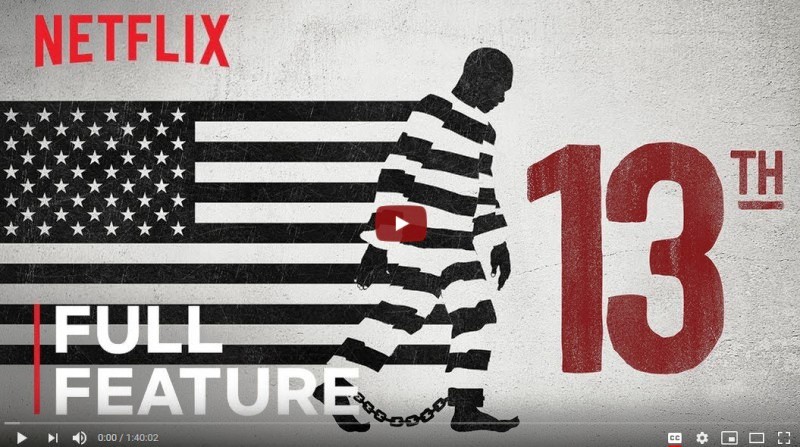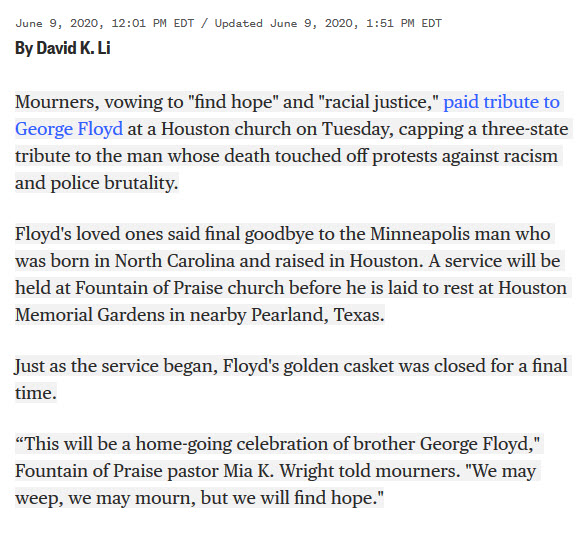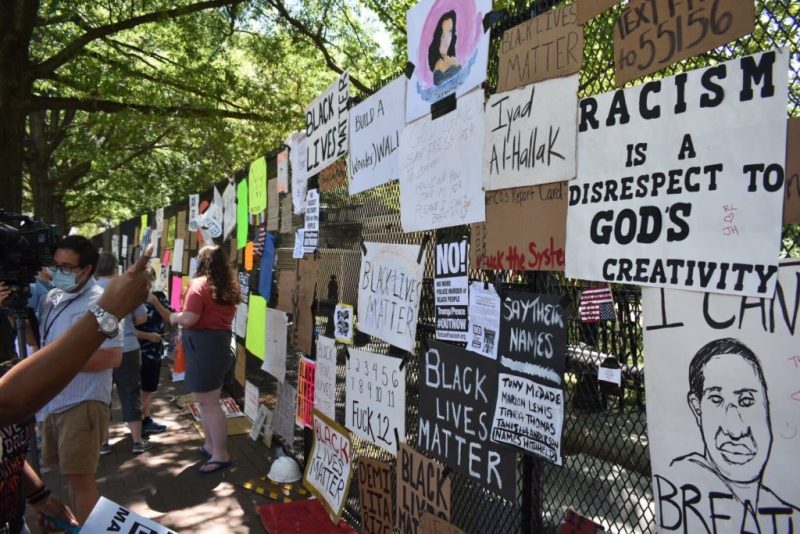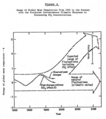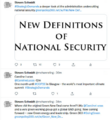Category:Social Justice: Difference between revisions
Siterunner (talk | contribs) No edit summary |
Siterunner (talk | contribs) No edit summary |
||
| (23 intermediate revisions by the same user not shown) | |||
| Line 1: | Line 1: | ||
<big>Intersectional, Social & Environmental</big> | |||
Social Activism | |||
[[File:Juneteenth.jpg]] | |||
June 19 marks the celebration of #Juneteenth , commemorating the day in 1865 when news of slavery’s end in the U.S. finally reached Texas, 2.5 years after the Emancipation Proclamation was signed. We celebrate this national holiday – also known as Freedom Day or Emancipation Day. | |||
························································· | |||
<big>Intersectional Environmentalism</big> | |||
[[Environmental Justice]] | |||
·············································· | |||
'''The NBA Wants to Talk About Social Justice''' | |||
Will People Listen? | |||
* https://www.bbc.com/sport/basketball/53556565 | |||
·············································· | |||
July 2020 | |||
John Lewis asked The NYT to publish this on the day of his funeral. He writes, “When you see something that is not right, you must say something ... Democracy is not a state. It is an act, and each generation must do its part.” | |||
* https://t.co/gNWQDpeAZt | |||
·············································· | |||
[https://www.youtube.com/watch?v=krfcq5pF8u8 <big><big>'''Watch the 13th on YouTube / Netflix'''</big></big>] | |||
[[File:Watch the 13th.jpg]] | |||
<big><big>'''The 13th Amendment'''</big></big> | |||
''In 1863 President Lincoln issued the [https://www.ourdocuments.gov/doc.php?flash=true&doc=34 Emancipation Proclamation] declaring “all persons held as slaves within any State, or designated part of a State, the people whereof shall then be in rebellion against the United States, shall be then, thenceforward, and forever free.” Nonetheless, the Emancipation Proclamation did not end slavery in the nation. Lincoln recognized that the Emancipation Proclamation would have to be followed by a constitutional amendment in order to guarantee the abolishment of slavery.'' | |||
[https://www.ourdocuments.gov/doc.php?flash=false&doc=40 '''''The Thirteenth Amendment to the US Constitution'''''] | |||
''The 13th amendment, officially abolishing slavery in the United States, passed the US Senate on April 8, 1864, and the US House on January 31, 1865.'' | |||
''On February 1, 1865, President Abraham Lincoln approved the Joint Resolution of Congress submitting the proposed amendment to the state legislatures. The necessary number of states ratified it by December 6, 1865.'' | |||
''The 13th amendment to the United States Constitution provides that "Neither slavery nor involuntary servitude, except as a punishment for crime whereof the party shall have been duly convicted, shall exist within the United States, or any place subject to their jurisdiction.'' | |||
<big><big>'''Southern slavery memories'''</big></big> | |||
[https://nyti.ms/3fJ8sz6 The Announcement on 'Juneteenth', June 19th, 1865] | |||
On June 19, 1865, the Emancipation Proclamation was announced in Texas and the surrender of the Southern army of General Lee became 'official' as a final state heard the Civil War was over. Freedom was arriving at last. The reality was much different, much harsher. | |||
Racism and acts of racism went on, transforming into different forms, personal and systemic. Discrimination, mass imprisonment and forced labor, peonage, brutality and worse, lynchings, continued in the South as a terrible legacy. | |||
''Within many political groups, racist beliefs were recast as with Democrats-Dixiecrats and Republicans over the years. In towns, in jails, in harsh, punitive laws, in 'Jim Crow' segregation, in intimidating forms, with violence of groups such as the KKK, fear mongering and hate spread. | |||
This harsh reality was met with faith and courage, day by day, year by year, and gradually progress was made in the struggle against deeply held racism. New voices and generations rose up. The 1960s marches, the Civil Rights Act, young voices with progressive beliefs grew, and expanded educational opportunity became reality in city after city. The racists lost in their attempts to stop progress. 'Dixie-Democrats' walked out of a changing Democratic Party in 1964 and 1968. The struggle continued in new ways across the US, and across the world. | |||
The battle for civil rights and human rights continues today, generation to generation, across states and nations. With hope for a better tomorrow being felt across the earth, an arc of justice can be seen growing. | |||
Today, it's fitting to speak of a new Independence Day. A 'Juneteenth holiday' being spoken of brings remembrance of a celebration of freedom and is another step forward in a long journey. | |||
We support the proposed new national Juneteenth holiday introduced this week formally in the US Senate by a TX Republican, John Cornyn, and in the US House of Representatives by a TX Dem, Sheila Jackson. | |||
[https://nyti.ms/3fJ8sz6 <big>'''''The 1865 Handwritten Order Marking Juneteenth'''''</big>] | |||
''NYT / June 19, 2020: The original written order to Texans that “all slaves are free” is found in a Union Army records book in the National Archives in Washington.'' | |||
''The re-location in the Army archive of the original announcement -- General Order No. 3 --- is historic.'' | |||
''The order was read aloud by a Union officer, Maj. Gen. Gordon Granger, in Galveston on June 19, 1865... That date, which became known as Juneteenth, has been celebrated ever since.'' | |||
''The discovery (of the order) was spurred by Michael Davis, a public affairs specialist for the National Archives who was writing a piece about the history of the holiday.'' | |||
''“In light of what has happened recently in our nation with police brutality, I wanted to make sure that we highlighted Juneteenth,” Mr. Davis said in an interview. He asked his colleagues if the archives had any documents from that day in 1865, hoping to find something but not sure that he would.'' | |||
''Trevor K. Plante, the director of archival operations at the National Archives building in Washington, zeroed in on the Union Army records from Texas. And on Thursday, in the stacks on the 10th tier of the building’s west side, he found a leather-bound book with a June 19 entry in neat cursive...'' | |||
''“The people of Texas are informed that, in accordance with a proclamation from the Executive of the United States, all slaves are free,” it said. “This involves an absolute equality of personal rights and rights of property between former masters and slaves and the connection heretofore existing between them becomes that between employer and hired labor.”'' | |||
''The document, encased in its original binding, was legible and in good condition, Mr. Plante said. “It’s more powerful when you see the handwritten version of it, as opposed to the printed versions that came much later,” he added, referring to the copies of Civil War documents that were compiled by the United States War Department (a precursor to the Department of Defense) around the end of the 19th century.'' | |||
<big><big>'''June 19th, Juneteenth 2020'''</big></big> | |||
A tip of our Green political hat to Will Sutton who writes from New Orleans on June 18, 2020 of a call rising across the U.S. for a national "Juneteenth" holiday. | |||
Mr. Sutton speaks of a historic first reading of the Emancipation Proclamation. | |||
:''The first Southern reading of the proclamation was in what is now Hampton, Virginia, and more specifically on land that is now Hampton University, my alma mater. You can’t attend Hampton and not learn about the Emancipation Oak.'' | |||
Over two years later came another reading. The people of Texas finally heard of the Emancipation Proclamation... | |||
:''June 19, 1865... the day they heard slavery ended. That day has been recognized — and celebrated — annually as Juneteenth since that’s the day that Union soldiers pulled into Galveston and told all who would listen that the Civil War had ended and enslaved people were free. That’s about two and a half years after Lincoln’s proclamation became law.'' | |||
:''"Juneteenth", June 19th... For all who want to celebrate Juneteenth — and I have been in that number — I support you.'' | |||
We at GreenPolicy360 support the call for and the cause of justice and freedom. | |||
<big>'''''Celebrating Freedom & Resilience'''''</big> | |||
''Remembering a Great Oak Tree of the South'' | |||
''One day in 1863, the members of the Virginia Peninsula’s black community gathered to hear a prayer answered. The [http://www.hamptonu.edu/about/emancipation_oak.cfm Emancipation Oak] was the site of the first Southern reading of President Lincoln’s Emancipation Proclamation.'' | |||
''With limbs over a hundred feet, the Emancipation Oak is designated as one of the 10 Great Trees of the World by the National Geographic Society.'' | |||
| Line 70: | Line 202: | ||
* https://en.wikipedia.org/wiki/George_Floyd_protests | * https://en.wikipedia.org/wiki/George_Floyd_protests | ||
The head of the US military, in battle fatigues, chose to accompany the US president across to St John's Church, after protestors were cleared away, enabling the president to conduct what was widely described as a "photo op." | The head of the US military, in battle fatigues, chose to accompany the US president across to St John's Church, after protestors were cleared away, enabling the president to conduct what was widely described as a "photo op." | ||
| Line 76: | Line 209: | ||
Now, thousands upon thousands, millions of stories are being told and actions taken. Social justice is on peoples minds. It is overdue. It is our common responsibility, each of us, to do what we can to make a positive difference in these times. | Now, thousands upon thousands, millions of stories are being told and actions taken. Social justice is on peoples minds. It is overdue. It is our common responsibility, each of us, to do what we can to make a positive difference in these times. | ||
················································· | |||
* https://www.npr.org/sections/codeswitch/2018/03/02/589483471/how-segregation-shapes-fatal-police-shootings | * https://www.npr.org/sections/codeswitch/2018/03/02/589483471/how-segregation-shapes-fatal-police-shootings | ||
| Line 87: | Line 222: | ||
* https://www.youtube.com/watch?v=qaPQN0aW47I | * https://www.youtube.com/watch?v=qaPQN0aW47I | ||
[[File:Redlining-2.png]] | |||
<big><big>[[Redlining]]</big></big> | |||
'''GreenPolicy360 looks back to work opposing 'redlining' ''' | |||
* https://www.greenpolicy360.net/w/Redlining | * https://www.greenpolicy360.net/w/Redlining | ||
················································· | |||
* https://en.wikipedia.org/wiki/Black_Lives_Matter | |||
* https://www.smithsonianmag.com/smithsonian-institution/long-lost-manuscript-contains-searing-eyewitness-account-tulsa-race-massacre-1921-180959251/ | * https://www.smithsonianmag.com/smithsonian-institution/long-lost-manuscript-contains-searing-eyewitness-account-tulsa-race-massacre-1921-180959251/ | ||
| Line 101: | Line 246: | ||
* https://www.commondreams.org/views/2010/04/19/diversity-dead-end-inclusiveness-without-accountability | * https://www.commondreams.org/views/2010/04/19/diversity-dead-end-inclusiveness-without-accountability | ||
* https://www.pachamama.org/social-justice/social-justice-issues | * https://www.pachamama.org/social-justice/social-justice-issues | ||
| Line 358: | Line 501: | ||
<big><big>'''Multiple Issues, Myriad Stories, a Colorful, Magnificent Cast of Characters'''<big><big> | |||
[[File:Diversity in Hollywood2.jpg]] | |||
| Line 369: | Line 520: | ||
[[Category:Disability Issues]] | [[Category:Disability Issues]] | ||
[[Category:Economic Development]] | [[Category:Economic Development]] | ||
[[Category:Eco-nomics]] | |||
[[Category:Elder Issues]] | [[Category:Elder Issues]] | ||
[[Category:Election System Reform]] | [[Category:Election System Reform]] | ||
| Line 374: | Line 526: | ||
[[Category:Green Politics]] | [[Category:Green Politics]] | ||
[[Category:Green Values]] | [[Category:Green Values]] | ||
[[Category:Health]] | |||
[[Category:Housing]] | [[Category:Housing]] | ||
[[Category:Human Rights]] | [[Category:Human Rights]] | ||
[[Category:Labor Issues]] | [[Category:Labor Issues]] | ||
[[Category:Media]] | |||
[[Category:New Economy]] | [[Category:New Economy]] | ||
[[Category:Peace]] | [[Category:Peace]] | ||
[[Category:Planet Citizens]] | [[Category:Planet Citizens]] | ||
[[Category:Resilience]] | [[Category:Resilience]] | ||
[[Category:Strategic Demands]] | [[Category:Strategic Demands]] | ||
[[Category:US]] | [[Category:US]] | ||
Latest revision as of 12:27, 19 June 2021
Intersectional, Social & Environmental
Social Activism
June 19 marks the celebration of #Juneteenth , commemorating the day in 1865 when news of slavery’s end in the U.S. finally reached Texas, 2.5 years after the Emancipation Proclamation was signed. We celebrate this national holiday – also known as Freedom Day or Emancipation Day.
·························································
Intersectional Environmentalism
··············································
The NBA Wants to Talk About Social Justice
Will People Listen?
··············································
July 2020
John Lewis asked The NYT to publish this on the day of his funeral. He writes, “When you see something that is not right, you must say something ... Democracy is not a state. It is an act, and each generation must do its part.”
··············································
Watch the 13th on YouTube / Netflix
The 13th Amendment
In 1863 President Lincoln issued the Emancipation Proclamation declaring “all persons held as slaves within any State, or designated part of a State, the people whereof shall then be in rebellion against the United States, shall be then, thenceforward, and forever free.” Nonetheless, the Emancipation Proclamation did not end slavery in the nation. Lincoln recognized that the Emancipation Proclamation would have to be followed by a constitutional amendment in order to guarantee the abolishment of slavery.
The Thirteenth Amendment to the US Constitution
The 13th amendment, officially abolishing slavery in the United States, passed the US Senate on April 8, 1864, and the US House on January 31, 1865.
On February 1, 1865, President Abraham Lincoln approved the Joint Resolution of Congress submitting the proposed amendment to the state legislatures. The necessary number of states ratified it by December 6, 1865.
The 13th amendment to the United States Constitution provides that "Neither slavery nor involuntary servitude, except as a punishment for crime whereof the party shall have been duly convicted, shall exist within the United States, or any place subject to their jurisdiction.
Southern slavery memories
The Announcement on 'Juneteenth', June 19th, 1865
On June 19, 1865, the Emancipation Proclamation was announced in Texas and the surrender of the Southern army of General Lee became 'official' as a final state heard the Civil War was over. Freedom was arriving at last. The reality was much different, much harsher.
Racism and acts of racism went on, transforming into different forms, personal and systemic. Discrimination, mass imprisonment and forced labor, peonage, brutality and worse, lynchings, continued in the South as a terrible legacy.
Within many political groups, racist beliefs were recast as with Democrats-Dixiecrats and Republicans over the years. In towns, in jails, in harsh, punitive laws, in 'Jim Crow' segregation, in intimidating forms, with violence of groups such as the KKK, fear mongering and hate spread.
This harsh reality was met with faith and courage, day by day, year by year, and gradually progress was made in the struggle against deeply held racism. New voices and generations rose up. The 1960s marches, the Civil Rights Act, young voices with progressive beliefs grew, and expanded educational opportunity became reality in city after city. The racists lost in their attempts to stop progress. 'Dixie-Democrats' walked out of a changing Democratic Party in 1964 and 1968. The struggle continued in new ways across the US, and across the world.
The battle for civil rights and human rights continues today, generation to generation, across states and nations. With hope for a better tomorrow being felt across the earth, an arc of justice can be seen growing.
Today, it's fitting to speak of a new Independence Day. A 'Juneteenth holiday' being spoken of brings remembrance of a celebration of freedom and is another step forward in a long journey.
We support the proposed new national Juneteenth holiday introduced this week formally in the US Senate by a TX Republican, John Cornyn, and in the US House of Representatives by a TX Dem, Sheila Jackson.
The 1865 Handwritten Order Marking Juneteenth
NYT / June 19, 2020: The original written order to Texans that “all slaves are free” is found in a Union Army records book in the National Archives in Washington.
The re-location in the Army archive of the original announcement -- General Order No. 3 --- is historic.
The order was read aloud by a Union officer, Maj. Gen. Gordon Granger, in Galveston on June 19, 1865... That date, which became known as Juneteenth, has been celebrated ever since.
The discovery (of the order) was spurred by Michael Davis, a public affairs specialist for the National Archives who was writing a piece about the history of the holiday.
“In light of what has happened recently in our nation with police brutality, I wanted to make sure that we highlighted Juneteenth,” Mr. Davis said in an interview. He asked his colleagues if the archives had any documents from that day in 1865, hoping to find something but not sure that he would.
Trevor K. Plante, the director of archival operations at the National Archives building in Washington, zeroed in on the Union Army records from Texas. And on Thursday, in the stacks on the 10th tier of the building’s west side, he found a leather-bound book with a June 19 entry in neat cursive...
“The people of Texas are informed that, in accordance with a proclamation from the Executive of the United States, all slaves are free,” it said. “This involves an absolute equality of personal rights and rights of property between former masters and slaves and the connection heretofore existing between them becomes that between employer and hired labor.”
The document, encased in its original binding, was legible and in good condition, Mr. Plante said. “It’s more powerful when you see the handwritten version of it, as opposed to the printed versions that came much later,” he added, referring to the copies of Civil War documents that were compiled by the United States War Department (a precursor to the Department of Defense) around the end of the 19th century.
June 19th, Juneteenth 2020
A tip of our Green political hat to Will Sutton who writes from New Orleans on June 18, 2020 of a call rising across the U.S. for a national "Juneteenth" holiday.
Mr. Sutton speaks of a historic first reading of the Emancipation Proclamation.
- The first Southern reading of the proclamation was in what is now Hampton, Virginia, and more specifically on land that is now Hampton University, my alma mater. You can’t attend Hampton and not learn about the Emancipation Oak.
Over two years later came another reading. The people of Texas finally heard of the Emancipation Proclamation...
- June 19, 1865... the day they heard slavery ended. That day has been recognized — and celebrated — annually as Juneteenth since that’s the day that Union soldiers pulled into Galveston and told all who would listen that the Civil War had ended and enslaved people were free. That’s about two and a half years after Lincoln’s proclamation became law.
- "Juneteenth", June 19th... For all who want to celebrate Juneteenth — and I have been in that number — I support you.
We at GreenPolicy360 support the call for and the cause of justice and freedom.
Celebrating Freedom & Resilience
Remembering a Great Oak Tree of the South
One day in 1863, the members of the Virginia Peninsula’s black community gathered to hear a prayer answered. The Emancipation Oak was the site of the first Southern reading of President Lincoln’s Emancipation Proclamation.
With limbs over a hundred feet, the Emancipation Oak is designated as one of the 10 Great Trees of the World by the National Geographic Society.
The road to social justice is a long, arduous journey, a path that is in no way for those who are unable or unwilling to face adversity and the pain of change.
Let us, here as a movement rises again, look to a 2019 book that deeply examines the fight for social justice in the United States.
The Second Founding: How the Civil War and Reconstruction Remade the Constitution
by Eric Foner
“A history of the Civil War amendments chronicles a revolution in law and moral sensibility.”
- David W. Blight, Yale University, author of the Pulitzer prize–winning Frederick Douglass: Prophet of Freedom
“How are voter suppression, mass incarceration, and jeopardy to the American-born children of undocumented immigrants possible in the land of the free? Eric Foner brings his masterful knowledge of Reconstruction to illuminate the transformative constitutional amendments following the Civil War, and powerfully conveys the ongoing struggles over their meaning.”
- Martha Minow, 300th Anniversary University Professor, Harvard University, author of In Brown’s Wake: Legacies of America’s Educational Landmark
About the Author
Eric Foner is the author of many award-winning books on the Civil War and Reconstruction, including 'The Fiery Trial: Abraham Lincoln and American Slavery', winner of the Pulitzer Prize. He is Professor Emeritus of History at Columbia University.
Reader Review, History that is timely and essential to know
We shouldn’t forget that the original United States Constitution, for all its brilliance, did explicitly condone the practice of slavery. For example, the “three-fifths compromise” counted slaves as three-fifths of a person for the purpose of calculating state representation in Congress, while Article 1, Section 9, Clause 1 prohibited Congress from passing laws banning slavery until 1808. Additionally, Article 4, Section 2 states, in essence, that escaped slaves must be returned to their owners in the original state from which they fled.
In other words, the Constitution was far from perfect (luckily, it allowed for its own modification). And that’s why many historians consider the “second founding” during the Reconstruction era to be of equal or greater significance than the founding itself. The Reconstruction era that followed the Civil War saw the passage of three amendments that would forever transform politics in the US, both in terms of civil rights and in the balance of power between the federal government and the states.
In “The Second Founding,” historian and Reconstruction expert Eric Foner tells the story of how these three amendments—the thirteenth, fourteenth, and fifteenth—together represent the foundation for the continuing struggle for universal rights. The abolition of slavery, birthright citizenship, equal protection under the laws, universal suffrage, and the Incorporation Doctrine (which forces the states to honor the Bill of Rights) are all the direct or indirect result of these three crucial amendments. And yet the “second founding” remains less well-known among the public than the first.
This book is the remedy for that gap in public knowledge, and is invaluable for understanding not only the Reconstruction era but also the subsequent civil rights movements and the modern conservative attack on equality. Foner shows, for example, how talk of “state rights” has almost always been a cover for blatant discrimination. “State rights” has variously meant the right to enslave, the right to deny the vote to blacks and women, the right to violate the Bill of Rights, and the right to discriminate based on race and gender. As Foner wrote, “Before the war, for example, southern states adopted laws making criticism of slavery a crime without violating the First Amendment since these were state laws and not acts of Congress.” The real danger, in terms of rights violations, has always been greater within the individual states.
This book can also act as a good inoculant against conservative rhetoric that hasn’t changed in at least 156 years. The reader will be amused to find the same state’s rights and reverse discrimination arguments throughout the book. Andrew Johnson, for example, in his opposition to the fourteenth amendment, said, “The distinction of race and color is by the bill made to operate in favor of the colored against the white race.” As Foner wrote, “In the idea that expanding the rights of nonwhites somehow punishes the white majority, the ghost of Andrew Johnson still haunts our discussions of race.”
The underlying message of the book seems to be that any rights granted by the Constitution are worthless if not enforced. Constitutional rights can be ignored, distorted, or narrowly interpreted to deprive certain groups of equal protection and treatment under the law. But if we can’t even recognize when this is happening—and we don’t properly understand what the second founding was trying to accomplish—then we are all powerless to prevent a regression to discriminatory politics under the guise of “state’s rights,” “originalism,” and all the rest.
~
Global, National, Local and Personal
Nation by nation, social justice is an ongoing struggle for liberties and rights, respect and understanding
In the United States from the beginning of the nation and passage of the US Constitution with its Bill of Rights, we have witnessed work in progress... in the Courts, in communities, person to person across generations.
GreenPolicy360 speaks of social justice as a global politics. Green politics brings forward a green platform of values and ideas that speak, first and foremost, of a rights agenda. Our GreenPolicy360 focus on rights is a foundation for action. Our belief in an expansive, living rights platform continues -- including civil, human, natural, racial, environmental, indigenous rights...
A foundation of rights, a set of beliefs and values, motivates our action at GreenPolicy360.
Visit actionable GreenPolicy360:
On June 1, 2020, in Washington DC, a peaceful protest was taking place across from the 'White House', the residence of the US president. The protest was part of a nationwide series of events/marches/speeches/gatherings and daily public protests over the tragic death of George Floyd.
The head of the US military, in battle fatigues, chose to accompany the US president across to St John's Church, after protestors were cleared away, enabling the president to conduct what was widely described as a "photo op."
Now, thousands upon thousands, millions of stories are being told and actions taken. Social justice is on peoples minds. It is overdue. It is our common responsibility, each of us, to do what we can to make a positive difference in these times.
·················································
GreenPolicy360 looks back to work opposing 'redlining'
·················································
·················································
The 8 Can't Wait Campaign @ https://8cantwait.org/ has immediate changes that are needed to cut back on the violence in cities across the country. Here are the 8. There are more than 8 needed.
1. Ban chokeholds and strangleholds
2. Require de-escalation
3. Require warning before shooting
4. Require exhausts all alternatives before shooting
5. Duty to intervene
6. Ban shooting at moving vehicles
7. Require use of force continuum
8. Require comprehensive reporting
·················································
Tuesday, June 9, 2020
- ························································································
After the Memorial Service of George Floyd
There's a street in Savannah called River Street. The street is paved and bumpy with paver stones laid there alongside the Savannah River. Few know these days that River Street is slave ship ballast, rocks that slave ships carried in their hold with the slaves. Over the yrs thousands of ships carried European-enslaved Africans, and African rocks -- chert, basalt -- quartz to the Southern city of Savannah, purposefully built on a native American graveyard site by an Englishman named General Oglethorpe.
The Africans had made a stop at Tybee Island, along Lazzaretto Creek, a lazzaretto its called, a quarantine stop. The chained people in the hold were counted, their saleable qualities written in detail on bills of lading and offer, preparing them for sale on River Street.
After they were unloaded, the African men then unloaded the rocks. This gave the slave traders an idea of how they would work in the fields. Then the slaves were chained to metal hooks in stonework along the river. The hooks are still there, tho few know what those rusty hooks in walls alongside River Street in Savannah were for. What people do know is that Savannah is known for being a haunted city. Not just because of all the literature, 'the book' and the movie that came from it, Midnight in the Garden of Good and Evil, and all the hanging moss, the deep humid smells, the whispers in the trees, the talk of spirits roaming still.
My first trip to Savannah told me this was a place where I should be very aware when I walked the streets at night. There are souls wandering still in Savannah. Savannah has lessons to tell us and if we stop and listen, we can hear them.
Stop and Listen
An old friend who used to edit at Roll Call and E&E Environment & Energy sent this to me. A June 9th editorial from his new venture, Maryland Matters.
Maryland does matter, as does its history, up the coast a bit from Georgia and split by pre Civil War Mason-Dixon line. The Province of Maryland saw the slavery line became a reality in 1767. Stones were placed every mile to mark the line between free and slave. Many of these original stones, rocks in the ground where on one side one could be free, in a manner of speaking, and on the other side, one could be owned and enslaved.
Let's look closer at the 'free' side in Maryland. Josh Kurtz and Maryland Matter lays it out for us. It's in the law, law and order of that time with the echoes still with us.
Read it slow, stop and listen to the voices:
Tucked between an early wrongful death statute titled “Negligence” and an article governing “Notaries Public,” sits Article 66 of the Maryland Code of 1860. Titled “Negroes,” Article 66 lays out the laws governing black life in the state of Maryland on the eve of the American Civil War across approximately 20 pages.
It is an example of one American state’s most fully formed corpus of law on the Black body. It is also an example of the American legal tradition of sanctioning and incentivizing the killing of black men by white citizens and law enforcement, a legacy reverberating in the recent murders of Ahmaud Arbery and George Floyd.
At the core of Article 66 is the impossibility of Black personhood, and this impossibility is achieved, in large part, by establishing a system of White control over the Black body. The article begins with the pronouncement that “Negroes have been held in slavery” in Maryland from its earliest settlement, and that “every owner of such negro is entitled to his service and labor for the life of such negro.” (Article 66, sec. 1).
This makes clear that there is no distinction between slave and Black person (“negro”), and that the power of Whites over Black bodies is perpetual. Later in the document (sec. 42), Article 66 prohibits the freeing of slaves by deed or last will and testament, meaning slaves could not be freed upon the death of their owner. This helped preserve the legal identity of the slave as property rather than person.
It is clear from Article 66 that this legal identity imposed on the Black body was enforced by conscripting White citizens into its enforcement. For example, section 47 required “All sheriffs and constables,” who then would have been White, to arrest any free Black person in the State from outside of Maryland, who were not allowed to enter the state (sec. 44).
But Article 66 also extended that same power to “all other [White] persons” who were also “authorized to arrest any such free negro” (sec. 47). White persons were not only authorized to arrest any free Black person from outside the state, they were entitled to half the $500 fine (in 1860) in the instance they arrested a free Black person for illegally entering Maryland a second time (sec. 44).
Thus, White persons were not only endowed with absolute authority over the bodies of “free” Black persons from outside Maryland, they were economically incentivized to exercise that authority and make White power over the Black body real. This economic incentivizing of the exercise of White power over the Black body is found throughout Article 66. (E.g., sec. 9, 46, 67-68, 70, 73).
Article 66 also encouraged White violence (read: use of force) against Black persons. For example, sec. 72 of Article 66 prohibited free Blacks from owning dogs without a permit, and the permit had to be renewed annually. The same section also authorizes “any person [to] kill any dog kept contrary to this section.”
In other words, any White person, upon the expiration of a Black person’s dog permit, had the legal right to kill that dog solely on that account. This is nothing other than the codification of an act of wanton cruelty against Black persons and families.
The greatest incitement to violence, however, rests in sections 3-11. Section 3 states that, “Any person may arrest any runaway negro, and carry him before a judge or justice.” Further, anyone attempting to do so was granted immunity for any use of force employed in the attempt:
“If any runaway slave shall resist the person who attempts to arrest him, and such slave happens to be slain for refusing to surrender himself, such killing shall be deemed justifiable; and any slave so killed shall be paid for by the State.” (sec. 11).
No other provision of Article 66 better contextualizes the rage currently being felt over the deaths of Black men at the hands of the State and their agents, many often White. How often has “resisting arrest” been used as a justification to murder a Black person? Here is its provenance in American law.
How often have we heard that the killing of a human being was justifiable because she resisted arrest? Here is its provenance in American law.
The Statues 'Honoring the Confederacy'
The memories from the past flow past us, a river of time in the South, the land of the 'Confederacy', the war to keep slavery a fact.
Here in Florida, where your writer resides, the ghosts of the past live in the present. Today, Confederate flags can be seen daily. Driving down the roads are Dixie flags in truck beds and rear windows, often displayed, if the words are said out in the open, by folks who believe still in 'the cause', the Southern cause in the Civil War.
Here in Florida, next to Georgia, not far from Savannah, the memories of slavery remain embedded in the land. Stone monuments to rebel troops, leaders and battlegrounds with places of 'honor' in our cities. Slavery's vestiges are still venerated, displayed and given salutes by some. But this is changing. The flow of time is bringing change, a new era even as those who honor the old ways call for another hurrah, another rebel yell.
But yesterday, June 9th, 2020, the tallest, historic Confederate monument was removed in the dark of night in Florida's largest city -- Jacksonville.
It happened in Hemming Plaza in the center of Jacksonville, the city named after the slayer of Indians, the seventh president of the United States known for slaughtering and removing the Native American tribes remaining in the South and marching them to reservations beyond the Mississippi River.
Andrew Jackson was celebrated for opening up 25 million acres of native peoples land to white settlement, in violation of treaties but there is was -- a slaughter in the name of 'civilization'. Their skin was dark, they had to go. They were 'savages'. They were hated. The Indian wars and white man plagues wiped out millions of the original people. Andrew Jackson led the troops against the Creek tribe. "We shot them like dogs," Davy Crockett is reported as saying in the news reports.
Three tribes had 21 million acres taken by Jackson who proclaimed to the US Congress, “They have neither the intelligence, the industry, the moral habits, nor the desire of improvement which are essential to any favorable change in their condition. Established in the midst of another and a superior race…they must necessarily yield to the force of circumstances and ere [before] long disappear.”
The U.S. Army removed 60,000 Indians. The removal and forced march was known as the “Trail of Tears.”
Today, in Andrew Jackson's city, Jacksonville, questions are being asked about how far the mayor who ordered the removal of the towering Hemming granite stone monument to the war for slavery.
What about the other Confederate monuments? Will they be removed too from their places 'of honor' in parks and be removed to museums and places where they will be regarded as historical artifacts with lessons to be learned about American past.
Or will the Jacksonville mayor go another way?
Today it was announced that Jacksonville looks to be the chosen site of the 2020 Republican convention. The US president decided, it's now being reported, that Florida is in, North Carolina is out. The long-planned convention in the Carolinas is being pulled as the North Carolina Governor was unwilling to give the president a demanded full-audience, no restrictions event in contravention to public health care experts warning against the spread of the Coronavirus, Covid-19.
And so it goes.
It used to be said that the powerful, the victors in war, write the history. To an extent, this has been shown to be true over the decades and centuries past.
Yet, there is another river of time, a River Street on which we are all traveling. It flows with its own force, it is a powerful force, moving, rippling, creating waves, eddies, currents.
The dynamic is happening here, today, with George Floyd, with the people rising up and saying 'let us breathe'. These are new times on River Street. We remember the old times. And we're learning.
~
GreenPolicy360
June 10, 2020
··············································
Saturday, June 6, 2020
Hundreds of thousands of people across the United States—and, in stunning displays of solidarity, around the world—poured into the streets Saturday demanding an end to police brutality and racial injustice in the largest day of demonstrations since the killing of George Floyd at the hands of Minneapolis officers last week.
Enormous and diverse crowds of demonstrators marched in the streets of Washington, D.C., Philadelphia, Chicago, and other major cities in a striking display of non-violent mass action. Participants in the historic demonstrations voiced hope that the remarkable energy behind the protests can be transformed into a sustained movement for change. (Via Common Dreams)
····················································································································
The Wars Come Home: Dissent and Discord in the US
Nationwide Demonstrations, a President's Threats
Washington Post / June 3 / Pentagon chief says he does not support the use of active-duty military forces to quell unrest, breaking with Trump
Repurposed from the Battlefields, Transferred to US Law Enforcement Agencies
Morning After Screenshots from DC / On June 2, 2020
········································
June 1 / 'The Photo Op' / An Update & Apology
‘I should not have been there,’ Gen. Milley says of Trump photo op.
The country’s top military official apologized on Thursday for taking part in President Trump’s walk across Lafayette Square for a photo op after authorities used tear gas and rubber bullets to clear the area of peaceful protesters.
“I should not have been there,” Gen. Mark A. Milley, the chairman of the Joint Chiefs of Staff, said in a prerecorded video commencement address to National Defense University, reports Helene Cooper. “My presence in that moment and in that environment created a perception of the military involved in domestic politics.”
······································
• #SocialJustice #EconomicJustice #ClimateJustice •
Social Justice • Economic Justice • Environmental Justice • Racial Justice
Social Justice Warriors • Grassroots Activism
Health Care • Public Health • Right to Health Care
Public Education • Rights to Equal Education
Human Rights • Womens Rights • Civil Rights • Voting Rights • Indigenous Peoples Rights
Community Justice • Policing Reform
Access to Justice • Affirmative Action • Equal Employment Opportunity • Worker Rights, Labor Laws
Eco-nomics • Sustainable Economics
Environmental Protection • Action on Climate Change - Global Warming
Human Need Programs to Deal with Hunger and Food Insecurity
LGBTQ+ Rights • Minority Legal Rights
Disability Rights - Elderly Care • Addressing Ageism
Migrants • Refugee Crisis • International Programs - Diplomacy
Prison Industrialization Reform
Prevention of Gun Violence
Veterans Health Programs • PTSD • Post War Care
Multiple Issues, Myriad Stories, a Colorful, Magnificent Cast of Characters
Subcategories
This category has the following 10 subcategories, out of 10 total.
A
E
P
V
W
Pages in category "Social Justice"
The following 66 pages are in this category, out of 66 total.
C
E
- Eco-economic Decoupling
- Eco-nomics
- Environmental full-cost accounting
- Environmental Justice
- Environmental Law, Rollbacks under Trump 2016-20
- Environmental Laws and Modern Environmental Movement
- Environmental movement
- Environmental Protection Agency
- ESA Living Planet Announcement - May 2022
- European Union Green Deal - Fit for 55
G
- GDP+
- Generation Green
- Glasgow Climate Summit - Pledges, Promises, Declarations - What's Next Up
- Going Green
- Google Earth Timelapse
- Green Bank in Maryland - and More
- Green Futurist Literary Writers
- Green Institute
- Green New Deal
- Green Party
- Green Politics 360
- Green Quotes
- Green Stories of the Day
- Green Stories of the Day - GreenPolicy360 Archive
- GreenLinks
- GreenPolicy360 Archive Highlights 2013
- GreenPolicy360 Archive Highlights 2014
- GreenPolicy360 Archive Highlights 2015
- GreenPolicy360 Archive Highlights 2016
- GreenPolicy360 Archive Highlights 2017
- GreenPolicy360 Archive Highlights 2018
- GreenPolicy360 Archive Highlights 2019
- GreenPolicy360 Archive Highlights 2020
- GreenPolicy360 Archive Highlights 2023
Media in category "Social Justice"
The following 200 files are in this category, out of 421 total.
(previous page) (next page)- 2020 record temperatures.png 800 × 502; 358 KB
- 7-20-2020 GreenPolicy360 RT No.2.jpg 591 × 510; 125 KB
- A Planet Citizen View.png 799 × 1,241; 1.64 MB
- A scorching year, what about the 360 warming data.jpg 600 × 706; 106 KB
- Acceptance on behalf of the United States of America.png 448 × 306; 62 KB
- Accessory Dwelling Units - Images varied-2.png 607 × 300; 329 KB
- Act now for a livable future.png 501 × 275; 272 KB
- Acting to make a positive difference - in St Petersburg Florida.png 600 × 723; 645 KB
- ADU 4-Tampa Case Study.png 682 × 806; 905 KB
- American Jobs Act compared w THRIVE Act (Green New Deal).jpg 674 × 798; 90 KB
- AOC re climate task force - july 8 2020.jpg 585 × 203; 38 KB
- Are Tiny Homes a Solution to the Housing Crisis.png 443 × 336; 286 KB
- Are Tiny Homes a Solution.png 408 × 303; 93 KB
- At Independence Hall - Sept 1, 2022.png 400 × 638; 416 KB
- Atmosphere Science.jpg 800 × 600; 45 KB
- Atmospheric Experiment of Humanity.jpg 519 × 574; 201 KB
- Banking - finance - climate - Mann-1.jpg 452 × 640; 162 KB
- Banking - finance - climate - Mann-2.jpg 452 × 640; 164 KB
- Battle for Democracy.jpg 640 × 123; 24 KB
- Bell hooks - when we love the earth.jpg 480 × 517; 128 KB
- Bernie Sanders, Senate 2.PNG 800 × 517; 379 KB
- Bernie Sanders, Senate Aug 3.PNG 800 × 518; 388 KB
- Beyond ludicrous politics in Florida March2015.png 761 × 251; 30 KB
- Biden - clean energy ambitions.JPG 640 × 334; 31 KB
- Biden introduces leadership team - Nov 24 2020.jpg 800 × 644; 173 KB
- Biden selects Kerry as special climate envoy.jpg 592 × 505; 87 KB
- Biden urged to act - Oct 18 2021 - The Guardian.png 663 × 600; 497 KB
- Biden's assembled an all-star climate team 4-21-2021.jpg 682 × 732; 309 KB
- Biden-Harris, CNN News Online - Nov 8, 2020.jpg 800 × 484; 114 KB
- Biden-Sanders Unity Task Force on Climate.jpg 701 × 780; 139 KB
- Big Oil Rocked by News May 27 2021.jpg 639 × 600; 84 KB
- Biggest climate related legislation in history - 1.png 800 × 188; 68 KB
- Bill McKibben to next generations.JPG 700 × 700; 203 KB
- Bill Nelson on Global Temp Rise and Climate Change.png 640 × 353; 100 KB
- Bill Nye The Planet's on Fire.jpg 800 × 675; 106 KB
- Bioneers 2023 - ThirdAct.Org.jpg 624 × 600; 145 KB
- Bioneers Conf 2021- Buckminster Fuller Instit joins.png 469 × 586; 599 KB
- Bioneers It's all connected - 30th annual conference.jpg 527 × 521; 79 KB
- Black Lives Matter - St. Pete FL.jpg 800 × 806; 174 KB
- Bloomberg Carbon Clock 10-26-2021 8-47-05 AM EST.png 800 × 195; 356 KB
- Blue Marble photo taken by the crew of Apollo 17 (1972).jpg 642 × 605; 129 KB
- Boxabl - The Casita.png 618 × 539; 246 KB
- Breakpoint - Reckoning with America's Environmental Crisis.jpg 329 × 500; 49 KB
- Breathing masks.jpg 800 × 531; 99 KB
- Bucky Trimtab.jpg 348 × 336; 88 KB
- Burst of climate denial as Trump presidency ends.jpg 632 × 604; 92 KB
- Car heating and cooling.png 465 × 635; 261 KB
- Carbon Brief - Greenhouse gas levels 2021.png 640 × 436; 292 KB
- Carbon Footprint - BP-McKibben-Solnit-Aug2021.jpg 516 × 264; 66 KB
- Carbon-footprint.jpg 297 × 516; 59 KB
- Caribbean Sea hot - June night 2024.png 676 × 600; 386 KB
- Casey Camp-Horinek.jpg 606 × 650; 132 KB
- CFSV2 world temp July 3, 2023.png 600 × 800; 513 KB
- CH4 graph - 1980-2020.JPG 640 × 446; 22 KB
- Changes in carbon dioxide per 1000 years - via Climate Central.jpg 682 × 424; 34 KB
- Check in.png 522 × 417; 193 KB
- Citizens Climate Lobby - Save Our Future Act 2021.jpg 518 × 262; 77 KB
- Climate action isn't 'bunny hugging' says Boris.jpg 800 × 264; 95 KB
- Climate activist - Steven Schmidt - 1978 on.png 600 × 480; 174 KB
- Climate Books - 2020.jpg 800 × 450; 69 KB
- Climate cases on the rise - Nature, Sept 2021.png 800 × 562; 181 KB
- Climate Change COP27 - Nov 11 2022 US Representatives.jpg 712 × 444; 54 KB
- Climate Change COP27 - Nov 11 Kathy Castor.jpg 712 × 710; 77 KB
- Climate Change Laws - database collaboration.png 640 × 271; 76 KB
- Climate Change Laws of the World - database.PNG 768 × 845; 383 KB
- Climate Change Litigation Databases Climate Law.png 800 × 330; 73 KB
- Climate Change US EPA.jpg 600 × 703; 95 KB
- Climate Conferences 1979-2020.jpg 768 × 768; 121 KB
- Climate Crisis and the Global Green New Deal.jpg 293 × 418; 33 KB
- Climate Desk.jpg 390 × 226; 21 KB
- Climate Emergency Institute - Oct 2022.png 610 × 600; 274 KB
- Climate Emergency Institute -- 2021.jpg 800 × 450; 55 KB
- Climate emergency.jpg 800 × 450; 69 KB
- Climate Headline News around the World - July 2023.jpg 600 × 704; 151 KB
- Climate Legacy of Biden.jpg 600 × 687; 265 KB
- Climate Migration Interactive Map.jpg 766 × 719; 58 KB
- Climate News - Oct 28 2022.jpg 626 × 600; 88 KB
- Climate News - United Nations Report - Feb 2022.png 768 × 878; 539 KB
- Climate News Dec 4 2023 in Dubai.png 800 × 1,037; 649 KB
- Climate Plans Enforcement - Resources - GreenPolicy.png 768 × 897; 686 KB
- Climate poll - Florida.png 640 × 267; 36 KB
- Climate strike - Week 171.png 739 × 600; 834 KB
- Climate Strike.jpg 560 × 387; 56 KB
- Climate Summit - Leonardo DiCaprio.png 600 × 663; 521 KB
- Climate Summit live updates - Nov 2 2021.png 751 × 600; 420 KB
- Climate Summit planned-1.jpg 800 × 301; 53 KB
- Climate Summit planned-2.jpg 800 × 187; 31 KB
- Climate Summit planned-3.jpg 800 × 278; 44 KB
- Climate Summit planned-4.jpg 800 × 241; 41 KB
- ClimateNewsFlorida.jpg 448 × 191; 36 KB
- CO2 cumulative emissions 1850 - 2021 - countries.jpg 640 × 462; 211 KB
- CO2 global pathways via IPCC AR6 - how will we respond.jpg 800 × 450; 57 KB
- COP26 Climate Summit concludes.jpg 600 × 800; 160 KB
- COP26 concludes - 2.png 648 × 467; 177 KB
- COP26 concludes - 3.png 648 × 713; 416 KB
- COP26 concludes.png 648 × 528; 329 KB
- COP26 in GLASGOW - 31 OCT-12 NOV 2021.jpg 800 × 264; 51 KB
- COP27 'opening speech'.png 640 × 460; 160 KB
- COP28 News - Dec 13 2023.png 800 × 898; 410 KB
- Coral bleaching - August 2023.png 488 × 430; 261 KB
- Coral bleaching - NOAA - August 2023.png 488 × 338; 201 KB
- Corita - Jerry Brown - Rule 7.png 800 × 453; 289 KB
- Corita action.jpg 410 × 342; 42 KB
- Cradle of Civilization - and climate change.jpg 640 × 360; 70 KB
- Dated record of Earths climate - Science Report Sept 10 2020.jpg 735 × 669; 192 KB
- Death Valley ... the heat, what its like.jpg 640 × 381; 62 KB
- Democratic National Convention-62 climate speakers.jpg 443 × 407; 57 KB
- Democratic Party Climate Bill - Aug 2022.png 640 × 269; 70 KB
- Diversity in Hollywood.png 777 × 493; 577 KB
- Diversity in Hollywood2.jpg 777 × 493; 64 KB
- Earth Day 2021 - Climate Summit News-1.jpg 491 × 270; 127 KB
- Earth Day 2022 - Act up.png 457 × 370; 155 KB
- Earth Emoji.png 50 × 50; 2 KB
- Earth grassroots.jpg 374 × 238; 32 KB
- Earth in Human Hands.jpg 325 × 385; 34 KB
- Earth in Our Hands.png 76 × 76; 5 KB
- Earth Summit 1992-s.png 336 × 418; 283 KB
- Earth Summit 1992.jpg 600 × 746; 171 KB
- Earth trapping unprecedented amount of heat - NASA.jpg 468 × 373; 56 KB
- Earth-upper-atmosphere-NASA.jpg 800 × 781; 327 KB
- Earths rotation as we roll thru space.jpg 800 × 529; 69 KB
- EarthScience Missions via the EOS - 2022.png 800 × 219; 139 KB
- EleanorRooseveltHumanRights.png 535 × 423; 60 KB
- Energy - Electric Measuring and Monitoring.png 715 × 1,978; 862 KB
- Energy Charter Treaty.jpg 512 × 480; 74 KB
- Environmental laws in US - Supreme Court votes soon.png 800 × 414; 334 KB
- Environmental Protection Agency logo.png 380 × 414; 39 KB
- EPA and the Green Bank - Feb 2023.png 476 × 542; 244 KB
- ESA Living Planet Symposium - Announcement.png 637 × 600; 508 KB
- ESA Living Planet Symposium - May 2022.png 700 × 600; 258 KB
- ESG Fight - Feb 2023.png 396 × 194; 88 KB
- Estuary in Clearwater on Tampa Bay.jpg 3,584 × 2,016; 1.5 MB
- EU agrees to cut emissions 55 percent by 2030.jpg 800 × 558; 96 KB
- EU unveils new climate change policy - July 14 2021 - 1.jpg 800 × 234; 33 KB
- EU unveils new climate change policy - July 14 2021 - 2.jpg 800 × 552; 86 KB
- EU unveils new climate change policy - July 14 2021 - 3.jpg 800 × 549; 89 KB
- EU unveils new climate change policy - July 14 2021 - 4.jpg 800 × 550; 92 KB
- EU unveils new climate change policy - July 14 2021 - 5.jpg 800 × 548; 88 KB
- EU unveils new climate change policy - July 14 2021 - 6.jpg 800 × 557; 89 KB
- EU unveils new climate change policy - July 14 2021 - 7.jpg 800 × 553; 92 KB
- EU unveils new climate change policy - July 14 2021 - 8.jpg 800 × 589; 91 KB
- Europe heat wave - July 19 2022 - via Copernicus satellite.png 600 × 639; 704 KB
- European Greens - Baerbock - Candidate for German Chancellorship.jpg 513 × 185; 37 KB
- European Greens EGPCongress Dec 2022.png 800 × 745; 640 KB
- Extreme temperature-world-May 2024.jpg 640 × 427; 105 KB
- ExxonMobil CO2 climatic response study - Graphic 1 - 1982.png 537 × 680; 150 KB
- ExxonMobil CO2 climatic response study - Graphic 2 - 1982.png 537 × 605; 112 KB
- Facts about US Energy Use.jpg 697 × 600; 101 KB
- FairVote.jpg 535 × 122; 14 KB
- Floating adaptations - GCA - for sea-level rise - circa 2023.png 600 × 732; 273 KB
- From 1968 to 1992 -- and the Journey continues....png 572 × 851; 320 KB
- George Floyd In-Memory.jpg 600 × 450; 68 KB
- George Floyd-2.jpg 594 × 362; 94 KB
- German foreign minister travels to India.png 640 × 178; 115 KB
- GHG forcings 1750-2020.png 531 × 531; 94 KB
- GHG ppt concentrations 1975-2020.jpg 640 × 361; 69 KB
- Ginsburg leaves a chasm on the Supreme Court.jpg 800 × 624; 92 KB
- Glasgow-Climate Conference News-Nov 6, 2021.png 600 × 800; 290 KB
- Glass Gem Corn.jpg 400 × 400; 21 KB
- Global Changes in temperature 1850-2020.jpg 480 × 480; 152 KB
- Global Climate Change textbook-Edition2.jpg 604 × 680; 96 KB
- Global climate conferences and GHG increases.jpg 793 × 801; 56 KB
- Global Climate Dashboard - NOAA - Climate.gov.png 630 × 480; 165 KB
- Global climate dashboard-NOAA climate.gov.jpg 521 × 221; 45 KB
- Global climate dashboard-www.climate.gov.jpg 800 × 489; 100 KB
- Global Climate Dashboard.jpg 800 × 529; 101 KB
- Global fossil fuel emissions - in a lifetime graphic.png 600 × 657; 233 KB
- Global greenhouse gas emissions - 1980 - 2020.png 640 × 480; 158 KB
- Global Stocktake, the first GST.jpg 800 × 905; 513 KB
- Global temperature change 1850-2016.gif 512 × 288; 1.38 MB
- Global temperature change 1901-2000.jpg 640 × 508; 47 KB
- Global temperature variations over past 200 years.jpg 640 × 360; 29 KB
- Global warming June 2024.jpg 640 × 174; 46 KB
- Google Earth Engine.png 448 × 165; 45 KB
- GP360 tagcloud2 m.png 531 × 324; 132 KB
- Green Branching Out.jpg 400 × 194; 35 KB
- Green Highlights.jpg 800 × 600; 121 KB
- Green Networking @GreenPolicy360.net.png 788 × 604; 764 KB
- Green New Deal - Strategic Demands - Oct 1, 2021.png 602 × 658; 245 KB
- Green New Deal in NYC.jpg 605 × 363; 53 KB
- Green Quotes - May 2022 - Green360.png 640 × 112; 46 KB
- Greeneuropeanjournal.eu.jpg 485 × 237; 30 KB
- Greenhouse gas levels hit record - Reuters.jpg 600 × 696; 104 KB
- GreenPartyPlatform 2000 KV10.png 338 × 531; 25 KB
- GreenPolicy360 - May- 9-2024.png 800 × 406; 119 KB
- GreenPolicy360 - May-10-2024.png 790 × 694; 320 KB
- Greens EU 2024.jpg 480 × 540; 91 KB
- Greta - the politics thats needed.jpg 639 × 203; 38 KB
- Greta anger into action.png 800 × 419; 528 KB
- Greta Looks Back.PNG 504 × 437; 368 KB
- Greta Thunberg - Week 203 Climate Strike Banner.png 209 × 127; 51 KB
- Greta Thunberg - Week 203 Climate Strike.png 554 × 601; 488 KB
- Hannah Arendt warns us.jpg 475 × 236; 20 KB
- Hannah Arendt.jpg 527 × 680; 51 KB
- Affordable Housing
- City Governments
- City-County Governments
- Civil Liberties
- Civil Rights
- Climate Change
- Disability Issues
- Economic Development
- Eco-nomics
- Elder Issues
- Election System Reform
- Education
- Green Politics
- Green Values
- Health
- Housing
- Human Rights
- Labor Issues
- Media
- New Economy
- Peace
- Planet Citizens
- Resilience
- Strategic Demands
- US
- Voting Systems
- Whole Earth
- Women's Issues
- Women's Rights
- Women and Gender
- Workers Rights
- Youth

